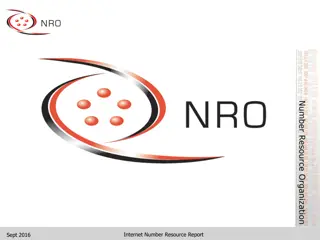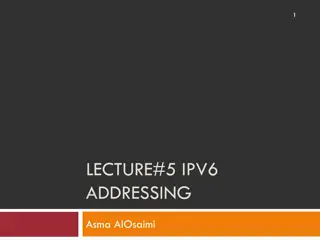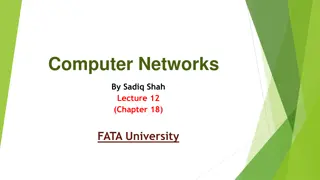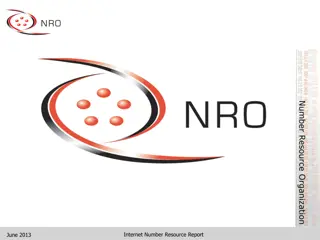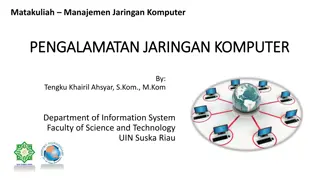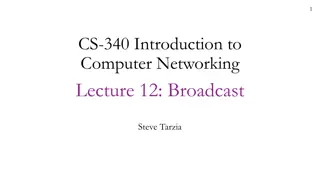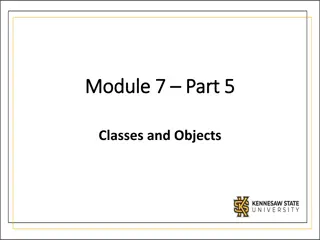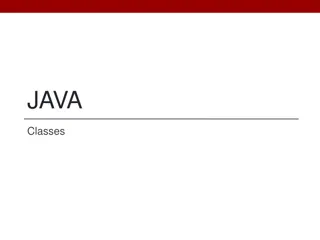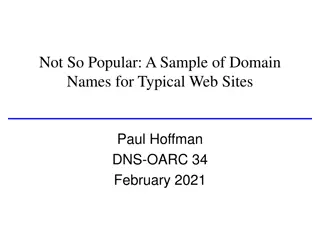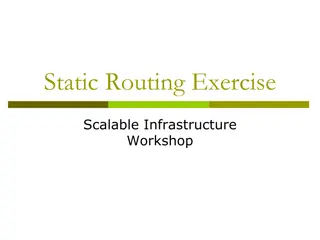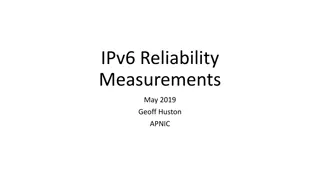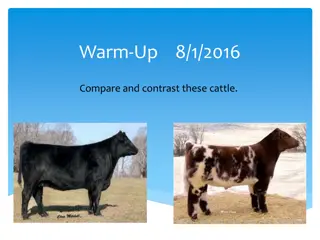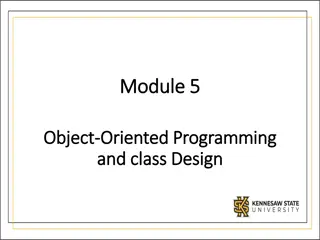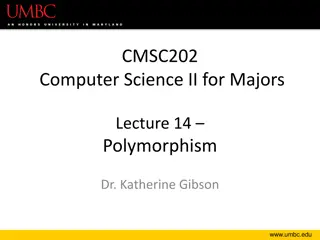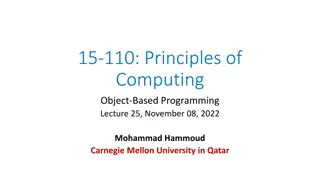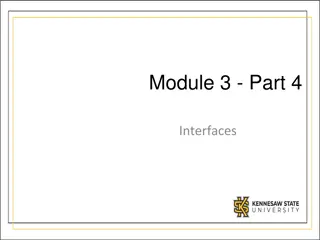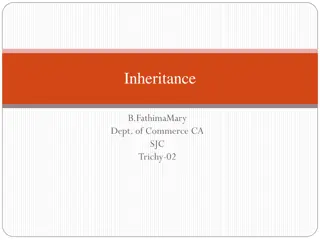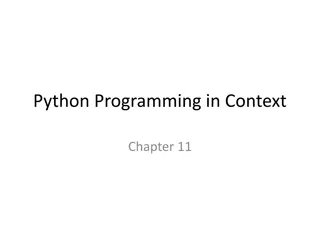Understanding IPv4 Addressing and Classes
Explore the fundamentals of IPv4 addressing including subnetting, VLSM, summarization, subnet masks, CIDR values, available host addresses, and broadcast addresses. Learn about IPv4 classes A, B, C, and D, their formats, usage for different network sizes, netmask details, IP address ranges, and more.
Download Presentation

Please find below an Image/Link to download the presentation.
The content on the website is provided AS IS for your information and personal use only. It may not be sold, licensed, or shared on other websites without obtaining consent from the author. Download presentation by click this link. If you encounter any issues during the download, it is possible that the publisher has removed the file from their server.
E N D
Presentation Transcript
Networks Fundamentals Mousa Al-Sahory
Chapter 7 Introduction IPv4 Classes IP Subnetting VLSM IP Summarization
IP Addressing Introduction
IP Addressing IPv4 Classes
IPv4Classes IPv4Classes
IPv4 Classes Class A ClassA: o Used for large networks. o Format: Network.Host.Host.Host o Netmask is 255.0.0.0 == /8 o Provides about 16.000.000 IPaddresses. o IP range for the first octet is (1-127). o Note: 127 is not used since it is used for testing purposes.
IPv4 Classes Class B ClassB: o Used for intermediate networks. o Format: Network.Network.Host.Host o Netmask is 255.255.0.0 == /16 o Provides about 64.000 IPaddresses. o IP range for the first octet is (128-191).
IPv4 Classes Class C ClassC: o Used for small networks. o Format: Network.Network.Network.Host o Netmask is 255.255.255.0 == /24 o Provides 256 IP addresses (Only 254 can be used for hosts because two IP addresses are excluded as one is used as a network address and the other as a broadcast address) o IP range for the first octet is (192-223).
IPv4 Classes Class D ClassD: o Used for multicasting purposes. o The multicast addresses are in the range 224.0.0.0 through 239.255.255.255. o Multicasting: sending data to hosts that belong to a multicast group.
IPv4 Classes Class E ClassE: o Used for research purposes & future use. o Class E range is 240.0.0.0 through 255.255.255.255
IP Addressing IP Subnetting
IPSubnetting Subnetting is logically dividing the network to subnetworks by increasing the 1 s used in the subnetmask The main idea of subnetting is saving IP addressesand use them according to hosts number that will be used in the network. Advantages o Saving IPs o Can divide network in smaller parts o Restrict Broadcasttraffic o Security o Simplified Administration
IPSubnetting Example: o 192.168.10.0/24: provides 254 IPaddresses. o In your network you have 20 hosts. o Without subnetting you will waste 234 IP addresses (254 20). Why wasting?? o The last octet of 192.168.10.0/24 consists of 8bits. o We have 20 hosts so we need to use only the last 5 bits of that octet since ((25) 2) = 30which covers the 20 hosts. o The remaining 3 bits will be added to the network part so that we have a /27 address.
IP Subnetting Formula Number of subnets 2x-2 Where X = number of bits borrowed Number of hosts 2y-2 Where y = number of 0 s Block Size = Total number ofaddresses Block Size = 256-Mask
IP Subnetting Subnet Mask Possible subnet maskvalues
IP Subnetting Subnet Mask CIDR /24 /25 /26 /27 /28 /29 /30 Mask 0 128 192 224 240 248 252
IP Subnetting Example Question: What are the subnet and broadcast addresses for the subnet which the IP 172.16.10.10 255.255.255.192 is a member of? Answer: 1) Find the block size 256 192 (last octet of the subnet mask) = 64. Block size =64. 2) Subnets are : 0, 64, 128,etc. The last octet of the IP is 10 and 10 is in the 0 subnet. 3) Then the subnet address is 172.16.10.0/26 4) The broadcast address is always (the next subnet 1) Current subnet = 0, next subnet = 64 broadcast address = 172.16.10.63
IP Subnetting Example Question: What are the subnet and broadcast addresses forthe subnet which the IP 172.16.88.20 255.255.240.0 is a member of? Answer: o 256 240 = 16, so the block sizeis 16.0. o Valid subnets are 16.0, 32.0, 48.0, , 80.0, 96.0, etc. o 88.20 is within 80.0 subnet, so the subnet address is 172.16.80.0/20 o Next subnet is 172.16.96.0, (broadcast address = next subnet 1) = 172.16.95.255
Addressing IP VLSM
VLSM Stands for Variable Length Subnet Mask Every subnet will have different subnet mask basedon requirement VLSM is a method of designating a different subnet maskfor the same network number on different subnets Can use a long mask on networks with few hosts anda shorter mask on subnets with manyhosts With VLSMs we can have different subnet masksfor different subnets.
VLSM Suppose we have the followingnetworks: o Network 1 with 60 hosts. o Network 2 with 30 hosts. o Network 3 with 10 hosts. The network address is 200.50.60.0/24 After subnetting: we will have 4 subnets each with 62IP addresses. Network 2 with 30 hosts and network 3 with 10 hosts will be assigned a subnet with 62 IP addresses and this will waste some IPaddresses. VLSM is used to save these IPaddresses.
VLSM We can say that VLSM is a subnetting for thesubnetting. In previous example, each subnet provides 62 IP addresses. For network 2 we need only 30 addresses and for network 3 we need only 10 addresses, so we do a subnetting for the subnet that provides 62 IPaddresses. Each subnet is a network in itsown.
VLSMExample VLSM allows us to use one class C (192.168.10.0/24) address to design a networking scheme to meet the following requirements: Bangalore Mumbai Sydney Singapore WAN1 WAN2 WAN3 2Hosts With normal subnetting a /26 mask was used to provide the 60 addresses for Bangalore and the other LANs. There are no addresses left for WAN links 60Hosts 28Hosts 12Hosts 12Hosts 2Hosts 2Hosts
VLSMExample WithVLSM
VLSMExercise 192.168.1.0/24
Subnetting & VLSM Exercise Find out the subnet and the broadcast addresses foreach subnet. Network address: 200.10.10.0/24 You have 3 networks: Network 1 with 50 hosts. Network 2 with 20 hosts. Network 3 with 10 hosts. Do it with normal subnetting and then withVLSM
IP Addressing IP Summarization
IP Summarization Summarization, also called route aggregation, allows routing protocols to advertise many networks as one address. The purpose of this is to reduce the size of routing tableson routers to save memory Route summarization (also called Route Aggregation or Supernetting) can reduce the number of routes that arouter mustmaintain Route summarization is possible only when aproper addressing plan is inplace Route summarization is most effective within a subnetted environment when the network addresses are in contiguous blocks
IP SummarizationExercise What is the most efficient summarization that R1 can useto advertise its networks toR2? A. 172.1.4.0/24- 172.1.5.0/24- 172.1.6.0/24-172.1.7.0/24 B.172.1.0.0/22 C. 172.1.4.0/25- 172.1.4.128/25-172.1.5.0/24-172.1.6.0/24- 172.1.7.0/24 D. 172.1.0.0/21 E. 172.1.4.0/22


